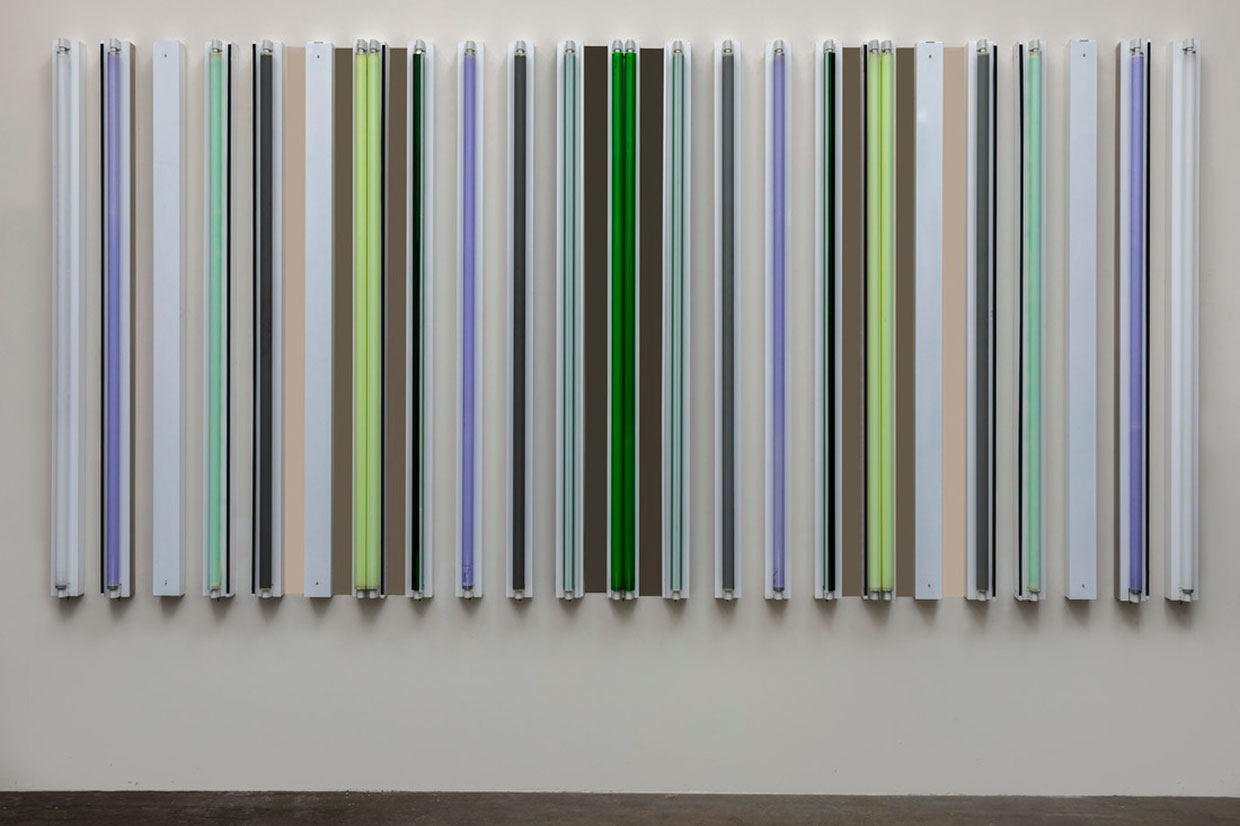ART CITIES: N.York-Robert Irwin
 For more than three decades, Robert Irwin has used fluorescent lights in his work, and in the last decade he has presented the bulbs and fixtures as the substrate of his sculptural environments. The new works in Pace’s presentation reflect Irwin’s insatiable and ongoing inquiry into the relationships between light, space, and human perception.
For more than three decades, Robert Irwin has used fluorescent lights in his work, and in the last decade he has presented the bulbs and fixtures as the substrate of his sculptural environments. The new works in Pace’s presentation reflect Irwin’s insatiable and ongoing inquiry into the relationships between light, space, and human perception.
By Efi Michalarou
Photo: Pace Gallery Archive

Robert Irwin’s solo exhibition feature seven new works from the artist’s “Unlight” series, including the largest work of this kind to date. in addition to an installation of six new works from Irwin’s series of columnar sculptures, which explore new chromatic terrain for the artist. All of the works on view in this exhibition are shown for the first time. Those from Irwin’s ongoing “Unlight” series have been created since the artist first debuted this body of work in 2020 at Pace Gallery in New York. Extending ever further his engagement with the conditions of human perception and the phenomenological effects of light, Irwin’s newest “Unlight” sculptures comprise constellations of unlit six-foot fluorescent fixtures and tubes, installed in vertical rows directly on the gallery walls. Covered in various applications of colored, translucent gels and thin strips of electrical tape, these works feature sumptuous and rhythmic compositions based on the subtle effects of the existing light in a given space, as registered in the reflective surfaces of the glass bulbs and anodised aluminium. The plays between Irwin’s abstract works and the surrounding room result in shifting patterns of shadow and tonality. Irwin’s latest “Unlight” works challenge viewers to see their environment in new and unexpected ways. Eschewing electrical power in favour of organic interactions, Irwin defies the viewer’s expectation of the banal objects—light fixtures and electrical tape—that comprise his sculptures. Neither is used for its ostensible purpose. Yet Irwin does not transform these everyday objects into the materials for his work. Instead, he uses them as instruments to conduct his actual materials: Shadow + Reflection + Color. Comprising not only the physical objects on the wall, but also these three ephemeral elements of perception, Irwin’s “Unlight” sculptures offer new possibilities for sensorial encounters between individuals and their surroundings. Installed on the Pace gallery’s seventh floor, Irwin’s new suite of columnar sculptures is constructed from sheets of acrylic pigmented in tones of grey and green, as well as red, which is a color that the artist has never previously explored in this body of work. Irwin has been experimenting with columnar forms made from transparent materials like acrylic since the 1960s, and Pace’s presentation offers a survey of the current state of this important valence of his larger practice. Illusionistic, layered, and multicoloured, Irwin’s columns evoke the energetic potentiality of light itself, capturing the radiance of colour almost as a physical entity and gesturing to the subjective nature of experience as well as the shared conditions of human perception.
Robert Irwin started his career as a painter in the 1950s. Though considered a defining figure of West Coast Abstract Expressionism, his focus was less the actual painting than the charged realm of experience that comes in to play between painting and viewer. Irwin’s interest in the phenomenological experience of art soon led him away from the gestural language favored by his colleagues and toward a radically reduced visual vocabulary of color fields and stripes. A further step came in the 1960s, when the artist dissolved conventional boundaries between painting and exhibition space by arranging disc-shaped paintings in such a way that they reflect various light sources. The resulting light installations became as integral to the work as the paintings themselves. In the 1970s, Irwin abandoned painting and studio work altogether and developed a kind of installation art devoted entirely to the phenomenology of perception. His early interventions, made with such modest materials as scrim, twine or adhesive tape probe the aesthetic potential of exhibition spaces by dismantling familiar patterns of perception and directing viewers’ attention to environmental qualities that already exist in a given space. From that basis, the artist radicalized his philosophy of aesthetic experience (ideas also reflected in Irwin’s many theoretical essays and lectures) and built a practice that consistently conceives of art as a response to the perceptual conditions of a specific site, whether spatial, cultural, historical or institutional. Some of Irwin’s interventions are of an almost inconspicuous, architectural nature. Others consist in installations employing such materials as fluorescent light tubes, semi-transparent Plexiglas walls, wire-and-steel constructions or colored aluminum panels. Some involve designing entire gardens. His work subverts the dominant logics of space and architecture by recalibrating the viewer’s physical and sensual experience, altering public space and creating surprising patterns of movement.
Photo: Robert Irwin, Greek Speak, 2021, Shadow + Reflection + Color, 6′ × 12′ 5-1/4″ × 4-1/4″ (182.9 cm × 379.1 cm × 10.8 cm), © Robert Irwin, Courtesy the artist and Pace Gallery
Info: Pace Gallery, 540 West 25th Street, New York, NY, USA, duration: 1-30/4/2022, Robert Irwin Days & Hours: Tue-Sat 10:00-18:00, www.pacegallery.com


